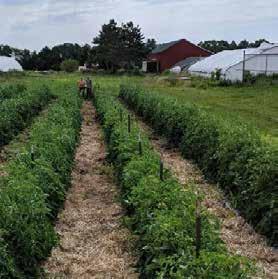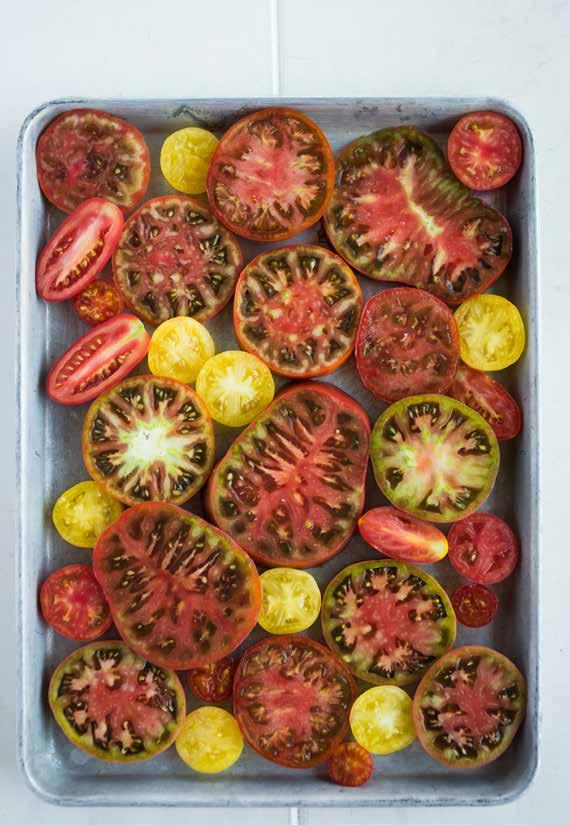 A member of Edible Communities
A member of Edible Communities





 A member of Edible Communities
A member of Edible Communities




there is nothing left to worry about the sun and her flowers are here. RUPI KAUR 6 NOTABLE EDIBLES by Emma Waldinger
GET OUT TO EAT GUIDE by Lauren Rudersdorf
RECIPE INDEX
DRINK LOCAL Untitled Art’s Florida Seltzers by Erica Krug
NOURISH Stonefruit Summer by Laura Poe Mathes
THE QUEST FOR FLAVOR: Trials for Taste in Organic Tomatoes at UW-Madison by Ámbar Carvallo
A FLAVORFUL SOLUTION: HERBS THAT PROMOTE POLLINATORS by Erin Presley

COOK AT HOME Savor Tomato Season by Lauren Rudersdorf
Tamales: a Family Affair Tomato-based Tamales from Guatamala by Claudia Irene Calderòn
Above: A bee collecting pollen from tomato blossoms.
Cover: Green Zebras, an oil painting from Jesse McNaughton. See profile on p. 5.
ámbar is a Chilean Plant Breeding and Plant Genetics Ph.D. student at UW-Madison. She has international experience in vegetable and ornamental production and is now focusing on breeding vegetables for organic systems. She advocates for participatory agricultural research while collaborating with private breeders, farmers, and chefs to carry out a variety of trials.
Claudia is a member of the Teaching Faculty in the Department of Horticulture at the University of Wisconsin. She was born in Guatemala, where she studied biology at Universidad de San Carlos de Guatemala. She then moved to Wisconsin to train in plant breeding and plant genetics. Her current research is focused on the intersection of gender, agroecology, crop evolution, sustainable food systems and food sovereignty.


Sunny is an editorial and commercial photographer with a studio on the west side of Madison where she lives with her husband, their two kids and a tiny dog. She specializes in food and product photography and loves the opportunity it gives her to connect with the many wonderful businesses and entrepreneurs in Madison.
Tracy is a graphic designer and photographer from Madison. A polymath at heart, she dabbles in various arenas of makery including cooking and baking, sewing and knitting, painting and collage, and has a soft spot in her heart for film photography. When she’s not busy making things, she enjoys travel, good food and drinks, gardening and live music.
Erica is a freelance writer from Madison. In addition to writing and helping to run youth writing summer camps, she also works for Rooted, a local nonprofit, where she supports statewide farmto-school efforts. Erica loves gardening, swimming in cold lakes and playing Yahtzee.


Laura is a registered dietician in private practice, focused on healing with real foods and herbs. She loves to spread knowledge and enthusiasm about great food, and teach traditional cooking and fermentation classes around the region. Originally from Missouri, Laura lives in Viroqua and now understands why cheese curds are a thing. She also loves to canoe, drink coffee and watch stand-up comedy.
Erin Presley manages the Herb, Woodland, and Pond Gardens at Olbrich Botanical Gardens. Her interests include native woodland plantings, sedges, American ginseng, low-maintenance and droughttolerant gardening styles, recycling coarse woody debris, and all things related to herbs, vegetables, and cooking. Never shy when it comes to sharing the joy of gardening, she has appeared on the PBS series Let’s Grow Stuff and Wisconsin Public Radio’s Garden Talk and is a contributor to Fine Gardening magazine.
MANAGING EDITOR
Lauren Langtim
PUBLISHERS
Christy McKenzie Cricket Redman
BUSINESS DIRECTOR Christy McKenzie
CREATIVE DIRECTOR Cricket Redman
SALES DIRECTOR Lauren Rudersdorf

LAYOUT Cricket Redman and Nicole Peaslee
COPY EDITOR Andrew Kay
CULINARY ADVISOR Christy McKenzie
SOCIAL & DIGITAL PRODUCER Lauren Rudersdorf
ADVERTISING & SPONSORSHIPS


Lauren Rudersdorf laurenr@ediblemadison.com
DRIFTLESS REGIONAL SALES MANAGER Kristen Wagner kristen@ediblemadison.com
CONTACT US Edible Madison 4313 Somerset Lane Madison, WI 53711 hello@ediblemadison.com .
Subscriptions are available beginning at $35 annually. Learn more at ediblemadison.com/subscribe
We want to hear your comments and ideas. To write to the editor, use the mailing address above or email hello@ediblemadison.com .
Edible Madison is published quarterly by Forager Publishing, LLC. All rights reserved. No part of this publication may be used without written permission by the publisher. ©2022.
Every effort is made to avoid errors, misspellings and omissions. If, however, an error comes to your attention, please accept our sincere apologies and notify us. Thank you.
VISIT US ONLINE AT EDIBLE MADISON.COM
Lauren is the voice behind the local food blog The Leek & The Carrot where she shares recipes and stories about life, food, and farming. Before that, she owned Raleigh’s Hillside Farm, an organic CSA vegetable farm, with her husband Kyle. She advocatea for local farms, local food, and cooking with the seasons. When she’s not writing or testing recipes in her sunny kitchen, she’s probably on a trail somewhere with her daughter Lillyan.


Emma (she/her) is a writer, grower and maker based in Madison. She cherishes warm summer memories spent at her grandparents’ hobby farm and harvesting from her family’s backyard vegetable garden. These experiences have catalyzed her fascination with the intersections between art, ecology, agricultudre and good food. When she’s not dreaming of the perfect cake, Emma helps to produce community events at Pasture and Plenty.

Our guiding word for this issue was Ripe, so you’ll find these pages bursting with the fruits of summer—tomatoes, most prominently. In fact, we’ve been informally referring to this issue as Ode to the Tomato.

Tomatoes are one of the most outgoing garden edibles. Even as little baby plants, they let off the most intoxicating scent. They’ll let you know exactly how they feel. They like it hot. They demand to be planted at juuuust the right time (a time known only to the weather gods). Too late and they’re unable to live up to their full potential during our short Wisconsin summers. Too soon and you may bear witness to an epic tragedy, like last summer, when a late May frost dashed my tomato dreams, decimating most of my plants and those of my neighbors in our community garden. (Oh, the hor ror!) They love to keep you guessing. What is the best way to prune them? When will they finally ripen? Answer: later than you think, and then all at once. After longing for good tomatoes all year, you’ll suddenly have more than you know what to do with.

Of course, all the drama of growing them is more than worth it. Bright, juicy, and full of personality, they’re the most glaring example of the often deep flavor gap between industrial agriculture and what you grow in your own backyard. Good tomatoes are precious, fleeting, and precious because they’re fleeting. All of the ways we’ve found to eat and store tomatoes are a negotiation with their fleeting nature. How do we enjoy this season to the fullest? How can we stay present through the longest, hottest, busiest days of the year? What do we do with all these tomatoes? Can we find time to put a few jars away for the slower months, when we’ll long for the sunny madness of summer? We hope this issue helps you take a little time out to ponder these questions and more.
Let’s dig in!
Lauren Langtim

P.S. As always, we welcome your thoughts and feedback. Drop us a line at hello@ediblemadison.com.
This summer, we’re expanding our online offerings—so don’t miss a beat— check us out online to find all our back issues, highlights of what’s in season, and recipes for all the bounty that’s in your CSA box and at the farmers’ market.
Plus Local Upstarts : a new, digital column published quarterly that celebrates local entrepreneurs. This series is funded by Upstart: a free entrepreneurship program for women and people of color run by the Wisconsin Alumni Research Foundation (WARF). The Upstart Program provides the tools and support to take a good business idea and start a successful business.
Read more at ediblemadison.com .
Artist Jesse Mangerson is a Madisonbased fine art painter and instructor, with 14 years of teaching experience at the graduate level, teaching both on site and online for the Academy of Art in San Francisco, CA. His recent work has focused on portrait, landscape, and still life commission paintings for local and national collectors. Jesse grew up in northern Wisconsin and spent summers workingas a 4th generation contributor to his family’s restaurant business in northern Indiana. The creativity of cooking and the food service industry helped him to live and work from New York City to San Francisco and several places in between.

More work can be seen online at jessemangerson.com or on instagram @jesse.mangerson. Contact Jesse for commission paintings at jesse.mangerson@gmail.com.
What is your favorite summer tomato memory?
When I was a kid, up north, the growing season for tomatoes was pretty short, so we’d end up with a couple of buckets’ worth of unripe tomatoes. Although my dad would cook some of these, the majority were used for the annual game of tomato baseball. We’d head across the street to Pioneer Park and set up in the baseball diamond. Dad would underhand us tomatoes and we’d splatter them back at him with our best swing of a baseball bat. We’d all end up covered in tomatoes with smiles on our faces.
Thick slices of Cherokee Purples, lightly salted with a drizzle of olive oil, alongside a petite arugula salad with shaved shallots and lemon zest dotted with sungolds, all topped off with a half of a round of burrata generously dressed with olive tapenade. A side of grilled baguette and a bottle of Sinksey rosé, sitting in the backyard with Carissa. I can’t think of much that beats that.
What inspired the piece?
Generally it’s a combination of being in the right place at the right time and giving myself the freedom to wander through the garden and just observe without a time frame. Green Zebras are not only delicious but also strikingly beautiful in color and design. I plant as wide a variety of heirlooms as I can get my hands on each May and hope that they do well in the garden for both eating and painting. These took off and were gorgeous! I was in the yard in the morning on a late July day with hopes of getting some images with a little dew on the fruit. I had been eyeing this group of tomatoes since they first started growing, hoping they’d all make it to being fully ripened without getting stolen by the chipmunks. The combination of this grouping with the dark values of the shaded trees, the saturation and variety of greens on the fruit and the leaves, and the little pops of orange lilies peeking through just begged to be painted. Patience paid off and I got my image as well as some wonderfully tart and sweet tomatoes.
Black currants are making a comeback. After nearly disappearing from the American culinary canon, this tart and earthy berry is again generating excitement for chefs and growers alike.
Black currants were banished for over five decades to protect white pines from blister rust during the lumber industry’s peak. Reintroduced with more diseaseresistance, these cold-hardy, shade-loving shrubs are great understory fillers for integrated fruit cropping systems.
In the last few years, chefs and agroforestry researchers, like the Savanna Institute, Chef Odessa Piper, and the chef team at Cadre in Madison, have teamed up to advance uses for black currants in the market.
Expect to see black currants on a menu at one of your favorite restaurants soon as kitchens find new connections with black currant farmers. Black currants can be used to make jellies, jams, syrups, wines, liqueurs, sorbets and ice creams, and so much more!

Visit our website to learn where you can find black currants growing locally.
Wisconsin Food Forests mimic forest ecosystems by planting gardens of trees, shrubs, and plants that provide food in spots that are accessible to urban neighborhoods. They are a project of Madison Traffic Garden, a non-profit organization made up of sustainable landscape designers, gardeners, locavores, naturalists, and enthusiasts who aim to plant the seedlings for food forests all over Dane County and beyond.
Find Them. You can find Wisconsin Food Forests projects at the Lansing Food Forest on the corner of Starkweather Drive and Richard Street in the Eastmoreland neighborhood. It’s a diverse food forest in an otherwise underutilized park space, including plants such as currants, stone fruits, herbs, rhubarb, and asparagus. You can also spot their projects at Troy Farm and the Farley Center.
»» wisconsinfoodforest s.com @wisconsinfoodforests

Ice Cream Social creates small-batch gluten-free ice creams with playful names and unique mix-ins, and donates a portion of its proceeds to important social justice causes.
Watch for summer menu for classics like:
Sweet corn ice cream with salted butter caramel swirls
Buttermilk ice cream, strawberry jam swirls, and cinnamon sugar caramelized bread crumb pieces

Crowds return every weekend to find new and creative seasonal flavors, so you might want to bring friends for company while you wait in line.
»» icecreamsocialwi.co m @icecreamsocial_wi

There’s no better way to spend a summer evening in Wisconsin than cutting the heat with a fruit popsicle. At Chrysalis Pops, individuals living with mental health challenges are offered meaningful paid work experience. Participants in the enterprise are involved in all steps of the process: growing, harvesting, producing, and selling organic fruit pops made with local ingredients.
Taste all of their unique flavors: Rhubarb Ginger, Strawberry Lemon, Cold Brew Coffee with Salted Vanilla, Raspberry Basil, Wisconsin-classic Sweet Corn, and more.
»» workwithchrysalis.org/programs/chrysalis-pops @chrysalispops
Ana Luyet and Carissa Mangerson of Tart Baked Goods make small batch pastries inspired by the bounty of our midwestern seasons.

For an extra punch of summer produce, check out their sweet and savory galettes filled with stone fruits, strawberries, cherry tomatoes, and other in-season fruits fresh from the harvest at Carandale Farms, Tree-Ripe Fruit Co, Forenoon Market, Door Creek Orchard, and many local vendors at farmers’ markets around town.
»» tartbakedgoods.com @tart_bakedgoods
Ugly Apple Café: Food Waste to Fruit Leather

Ugly Apple Café is making food waste into fruit leather. Using simple ingredients from fruit overstock at local orchards, they’re maximizing perfectly edible fruit that would otherwise go to waste and recovering it in a wholesome, sweet snack. Try their Apple Straps in fun flavors like Apple, Apple Cranberry Ginger, and Apple Chia Seed Spice.
»» uglyapplecafe.com/fruit-leather
There’s no better time than summer to get out and explore our region. Whether you want to grab a picnic, find a new al fresco favorite or make your destination a dinner, options abound in southern Wisconsin. Here are a few spots to get you started.
2540 University Ave, Madison | 608-819-8555
Tu-F 3pm - 10pm; Sa 4pm - 10pm
Founded in the fall of 2019, Cadre is a French-inspired restaurant locat ed in the Regent neighborhood of Madison. Cadre’s mission is to create a welcoming and educational dining experience using locally-sourced, respectfully prepared ingredients. cadrerestaurant.com, @cadremadison, info@cadrerestaurant.com

10229 Sharp Rd, Mount Horeb | 608-320-9287
F 4:30pm - 9pm; Sa 3pm - 9pm
Campo di Bella is a family-owned and operated farm-to-table restaurant and winery offering unique, on-farm dining experiences. Open Friday and Saturday evenings year round. Enjoy a special evening on their outdoor patio overlooking farm fields. To view and purchase dinner reservations, go to campodibella.com under the dining tab. campodibella.com, @campodibella
1219 North Sherman Avenue, Madison | 608-250-0035, F, Sa, Su 8:30am - 12pm
Madison’s Northside tiny bakery on wheels! Far Breton Bakery makes artisan pastries from scratch in the style of rural France (croissants, kouign amman, galettes, etc). Available Saturday at the entrance to Maple Bluff (off Sherman Ave) and Sundays at the Northside Farmers’ Market. Pre-order online at farbretonbakery.com. farbretonbakery.com, @farbretonbakery
8430 Old Sauk Rd, Madison | 608-820-1210
M-Su 11am - 8pm
Nutritious salads and grain bowls made with fresh and local ingredients. Forage Kitchen is dedicated to bringing healthy foods to the local community at four locations throughout the Madison Metro area: State Street, Hilldale, Monona, and Middleton. foragemadison.com, @forage_kitchen
3241 Garver Green, Madison | 901-264-0228
W 4pm - 9pm; Th-F 4pm - 10pm; Sa 10am - 10pm; Su 10am - 3pm Get a taste of what the private events company at the historic Garver Feed Mill has to offer in their lounge, which is open to the public five days a week. The Garver Lounge offers cocktails, brunch, local brews, upscale bar fare (including vegan and gluten free options), occasional live music, and a cool, casual Garver Feed Mill experience. garverevents.com/lounge, @garverlounge/@garverevents
131 East Mifflin St, Madison | 608-283-9500
Tu-Th 4pm - 9pm, F-Sa 4pm - 10pm, Sa-Su 10am - 2pm
One block off Madison’s Capitol Square, Wisconsin’s finest ingredients meet global inspiration, culinary excellence and expertly crafted cocktails at Heritage Tavern. Enjoy twists on familiar dishes using local and sustainable ingredients. Brought to you by Chef Dan Fox, Madison Magazine 2013 Chef of the Year and three-time James Beard Award finalist. heritagetavern.com, @heritagetavern
242 North Lexington Street, Spring Green | 608-459-5313
M,Th, F, S 11:30am - 2:30pm and 5pm - 9pm. Su 10am - 2pm
Locally-focused casual fine dining restaurant. Natural wine, Wisconsin craft beers, and delicious cocktails. Indoor dining and outdoor dining in our garden are available for summer. Family and dog friendly. Woodfired pizza, fish, vegetables, and more. homecomingspringgreen.com, @homecomingspringgreen
1046 East Washington Ave, Madison | 608-255-5225
M-Th 11am — 9pm; F, Sa 11am — 10pm; Su 4pm — 9pm Jacknife rethinks the way fast-casual food makes you feel. By creating food that’s healthy, delicious, and always made with the highest-quality ingredients, they reshapehe way people enjoy not only sushi but fast-casual food in general. Their fresh, local ingredients will fill you up and make you feel good. getjacknife.com, @ilovejacknif
60 South Main St, Janesville | 608-563-1800
Tu, W, Th 4pm - 9pm; F, Sa 4pm - 11 pm, Closed Su-M
With its warm, intimate atmosphere, acclaimed food and craft cock tails, Lark is the spot for a relaxed evening with friends in the heart of downtown Janesville. Their menu features a three-course prix fixe meal that changes monthly and thoughtful selection of small and large plates with seasonal and international influences. larkjanesville.com, @larkjanesville
2601 West Beltline Hwy, Suite #106 Madison | 608-630-8194 M-Su 8am - 8pm
At Migrants, Chef Oscar brings locally sourced pasture-raised meat and vegetable tacos to Madison. Corn and flour tortillas are handmade daily. All ingredients are locally sourced, GMO free, or organic. migrantsmadison.com, @migrantsmadison
110 West Court St, Viroqua | 608-638-2743 W-Sa 10am - 7pm
A specialty cheese store celebrating American farmstead cheeses as well as cheese and charcuterie from around the globe. Coffee, soft drinks, soup, sandwiches, salads and desserts are all available. Plus small plates, cheese boards, stuff to feed your kids and an exceptional retail and wine selection. Celebrating good food. noblerind.com, @noblerind
1344 East Washington Ave, Madison | 608-819-8002
100 Cross Country Rd, Verona | 608-497-3333
6712 Frank Lloyd Wright Ave, Middleton | 608-203-6116
Tu-Sa 11:30am - 9pm; Su- M Closed

Locally owned Southwestern-inspried from scratch fare with a newfangled twist! With over 100+ tequila options at each of our locations consisting of only 100% Weber Blue Agave & a fun, welcoming atmosphere! Come celebrate in good food! pasqualscantina.com, @pasqualscantina
The interior of Jacknife. Be sure to check out the mural while you nosh. If you order online, grab your meal from a chilled locker right by the door

2817 East Washington Ave, Madison | 608-443-9111
W, Th, F 11am - 8pm; Sa 12pm - 9pm JustVeggiez is a 100% black, family-run vegan restaurant, catering, and vendor service that provides a healthier version of your favorite foods. Fresh and local ingredients. Eat well. Be happy.. JustVeggiez.com, @justveggiez
316 West Washington Ave, Suite 100 Madison | 608-294-1234
Su–Th 4:30pm - 9pm; F, Sa 4:30pm - 10pm
Just seconds from the Capitol, you’ll find the city’s most exciting dining experience. It starts with a menu that spans continents and goes far beyond sushi. The sculpted interior space is the perfect place to relax, grab a romantic dinner, or overwhelm your senses at their chef’s table. Every moment at RED creates a memorable experience. red-madison.com, @redmadisonwi
121 S Main St, Lake Mills | 920-320-9735
Su 12pm - 8pm, Tu-F 5pm - 10pm, Sa 12pm - 10pm
Sunshine Brewing Company is a small batch brewery with a specialty in Belgian style ales. Their taproom sits on Mill Pond and offers Southern California-style Mexican food, a great vibe, and a beer garden with sunset views. sunshinebrewco.com, @sunshinebrewco
North: 2817 North Sherman Ave, Madison | 608-271-4422
M-Su 8am - 8pm
West: 6825 University Ave, Middleton | 608-284-7800
M-Su 8am - 9pm
East: 1221 Williamson St, Madison | 608-251-6776
M-Su 7:30am - 9pm
Willy Street Co-op is a natural foods grocery cooperative specializing in local, organic, and sustainable foods where everyone is welcome. Three stores in the greater Madison area offer grab and go salads, sandwiches, wraps, juices, and desserts, as well as hot food bars, all made locally in their delis and production kitchen. willystreet.coop, @willystcoop
Friends enjoying a Dragon Roll on the dog friendly patio at RED.

219 South Main St, Viroqua | 608-638-6294
W-Sa 11am - 10pm; Su 10am - 7pm

Spirited deli with a curated grill and craft bar. Enjoy lively interpreta tions of your favorite meals as well as chef-and-farmer driven plates designed for sharing in their warm and relaxed atmosphere, with occasional live music! @salt_and_tipple

54 South Main St, Janesville | 608-607-0037
T, W, Th, F, Sa 11am - 7:30pm
Sandwich Bar offers creative, gourmet sandwiches and a selection of beer, wine and cocktails for lunch and dinner. Their interior features mu rals painted by Brooklyn artist Jeff Henriquez. Trivia every Wednesday night. sandwichbarjanesville.com, sandwichbarjville
1746 Hwy 73, Cambridge | 608-469-2319
1st & 3rd Sundays from May-October 2:30-8 p.m.
Sprouting Acres certified organic CSA farm has been delivering fresh produce to Madison and the surrounding area for almost 20 years. Now they are beginning their fourth season of pizza nights and live music on the farm as well as space to rent out for private events. sproutingacres.com, FB: @sproutingacresfarmandpizza
IG: @sproutingacres
Sunshine Brewing Company is a great bikeable destination, just a couple blocks off the Glacial Drumlin State Trail in Lake Mills.
105 South 2nd St, Mount Horeb | 608-437-2739 S, M, Tu, W, Th 11am - 9pm F, Sa 11am - 10pm
The Grumpy Troll is an award-winning brewpub with bold and creative handcrafted ales and lagers brewed right on-site! Their menu offers masterfully built burgers & sandwiches, mouth-watering pasta, house-made soups, salads and filling appetizers. The Biergarten offers year-round outdoor seating and the newly remodeled Taproom upstairs is a great space for gathering with friends and family. thegrumpytroll.com, @grumpytrollbrew
Various locations across Madison Hours change weekly. Follow us for weekly schedule and locations. Vengan Pa’ Ka is a farm-to-cart mobile food truck dishing out innovative vegan cuisine. Sustainability is at the forefront of VPK’s ideology and they’re on a mission to provide sustainably grown, organic, plant-based products while supporting a conscious lifestyle. By deploying innovative culinary techniques, VPK hopes to entice even the non-vegan popula tion into enjoying dishes that contribute to environmental sustainability. venganpaka.com, @venganpaka
Choose from grab & go salads, sandwiches, juices, sushi and more.

27 West Main St, Madison | 608.283.9478
M-Th 7am - 2:30pm; F-Su 7am - 4pm
302 S Main St, Viroqua | 608.638.7701
M-Su 7am-5pm
Visit the café on Capitol Square and experience spectacular organic coffee, roasted in Viroqua and prepared by Madison’s finest baristas. Stay for a bite and you’ll see and taste a vibrant food menu made of locally sourced, organic ingredients. wonderstate.com, @wonderstatevrq
Award winning plant-based nachos featuring house-made “Smoked Goodah.”







interview I ask Levi Funk, craft brewery Untitled Art’s founder, the question burning in my mind. We are sitting in a tiny room at Octopi Brewing, the contract beverage facility and taproom in Waunakee where Untitled’s products are brewed. I’m wondering how Untitled’s Florida Seltzers taste so fruity compared to other hard seltzers. I’m picturing stomping on fruit in a giant vat, a la Lucille Ball in that episode of I Love Lucy. Is that how it is? Just stomping on oranges? Funk raises his eyebrows and pauses before replying, “I mean, you could do that to make seltzer if you were not doing it 200 barrels at a time. We work with suppliers who give us juice or puree, so the fruit has already been smashed—so we don’t have to smash it with our feet.”
Untitled Art launched its line of hard seltzers in 2020, one year after the ‘Summer of White Claw.’ Love it or hate it, “White Claw is who built that style,” Funk says. “It’s kind of weird because there were products that weren’t that far off from what White Claw was from a product standpoint, but certainly White Claw created and blew up what we call hard seltzers.” Ignoring those who said it was just a fad, Funk became interested in creating his own version of the popular beverage. “In the craft beer world there was this tendency to say seltzer isn’t beer and that it’s a ‘less-than’ style,” Funk says. “I saw the same thing happen with New England IPA. All these West Coast brewers were like, ‘New England IPA is not real brewing—you are doing a bad job of making beer, you are wasting hops.’ But there is a tendency in the beer world to view any innovation as a threat to the tradition.”

So when Octopi got new pieces of equipment that made it possible to brew hard seltzers, Funk jumped at the opportunity. “The question in my mind was, How does a craft brewery make a seltzer? If we don’t reject the base—if we view it as a new base like New England IPA—then how do we create a craft product?”
Experimentation is nothing new to Funk, who opened Funk Factory Geuzeria, his first brewery—or blendery—on the south side of Madison in 2012. Born in Iowa, Funk grew up in the La Crosse area. “I got into beer as a consumer, as a fan,” he says. “And then eventually [I got] into sour beer and lambic, that style. In Belgian lambic production there is a blendery business model where you don’t brew but you buy stock and do blending. I was curious if that model would work in the US, and that question led to starting Funk Factory.” A very “niche” category of beer, “It’s very nerdy but it’s a lot of fun,” Funk says. “It is also very, very traditional.”

While traveling Funk got a chance to see what was up and coming in the beer world, and he eventually approached Isaac Showaki, Octopi’s founder, about starting a “clean” brand of beer. “These are the styles of beers that would never be made at Funk Factory,” Funk notes. “We are doing mixed ferm there, so it doesn’t have to be sterile and you don’t have to worry about infection, because all the beer is infected there. To make a clean beer in that environment would be difficult from a production standpoint, and it doesn’t fit the ethos of what Funk Factory is.”
When Funk started Untitled Art in 2016—the team has since grown to about 15 people, its products now distributed to more than 20 states—he had a clear goal: “I [wanted] to make these beers that I would see out at festivals being produced on the East Coast or West Coast, or even overseas, and bring it back to Wisconsin and produce an example of that here.” The name Untitled, with its
Untitled Art uses fruit puree to flavor their hard seltzers.

“For us, with [our] Florida Seltzer, it’s kind of a hat tip to the evolution of craft beers,” Funk says. “Saying we are going to evolve hard seltzers, and instead of using the essence of fruit we are going to use a lot of fruit in them. Actual, real fruit.”
stark logo of black letters on a white background, was meant to counter the hype that often surrounds other craft beer brands and labels, which capitalize on keywords meant to affect your impression of the products. “I wanted to strip all that away,” Funk says. “It feels like when you are at a gallery and you are looking at this painting and you don’t really understand it and then you read this description and then you understand it… or think you understand it. You can go through a gallery and do that, but you might find that statue in the middle of the room without any information on it is the thing you found the most beautiful. That is what I wanted to create.”
After finding early success with stouts and hazy IPAs, in 2020 Untitled launched its popular line of fully fermented, non-alcoholic beers, in addition to its fruit-forward Florida Seltzers. Both products were made possible by equipment available at Octopi. “It was seeing new equipment coming into the facility and saying ‘How am I going to use that?’”


Funk recalls. “Florida Seltzer was that: we have this equipment and this equipment; if I merge those together I can make Florida Seltzer.”





In this case the equipment included a highpressure membrane filter that creates a clean hard-seltzer base. “It’s actually the same process that White Claw uses,” Funk says. It also included a tunnel pasteurizer. “I could add fruit to a very clean base and I could pasteurize it so it was stable. So you were left with the sugars, the sweetness of the fruit, and you didn’t have to add anything artificial to it.” Which answers the question of why Untitled’s Florida Seltzers taste so much fruitier than those sold by White Claw or Truly, “which are clear liquid using extract and not any fruit.”
Untitled’s hard seltzer flagship flavor, Prick ly Pear Guava, was a nod to the tropics and remains in rotation. Other flavors soon fol lowed, including Raspberry Lime, Blueber ry, Black Cherry, and Pineapple Mango. This summer’s variety pack, featuring Strawberry Kiwi and Navel Orange Yuzu, will be joined by two new flavors: Meyer Lemon Water melon and Apricot Kumquat. Rocket Popsi cle, a seltzer base with Bomb Pop flavorings of blue raspberry, cherry, and lime, will make its second appearance in stores during the latter half of June, in time for the Fourth of July. “That is just kind of a fun one,” Funk says. “No sense of ‘We’re making a good-for-you product’; we’re making an alcoholic popsi cle beverage. And it’s blue!” A one-off flavor, Black Mangosteen, will be available in stores in August. And whatever flavor comes next, rest assured it will taste like its name. “For us, with [our] Florida Seltzer, it’s kind of a hat tip to the evolution of craft beers,” Funk says. “ “[We’re] saying we are going to evolve hard seltzer, but instead of using the essence of fruit we are going to use a lot of actual, real fruit.”
Botanical
AWILDAN.COM @awildandistilling awildandistilling
THECIDERFARM.COM
@the_cider_farm theciderfarm
Spirits made from scratch in the heart of Madison. Bourbon release this summer!
Spirits made from scratch in the heart of Madison. Bourbon release this summer!
OLDSUGARDISTILLERY.COM
OLDSUGARDISTILLERY.COM
Tangy mixers best served splashed into a cocktail, mocktail or sparkling water. A women-owned company!



SIRENSHRUBS.COM @sirenshrubs
Botanical seltzer filled with prebiotic plant fiber, natural antioxidants & adaptogens to keep you feeling good.
DRINKGIST.COM
DRINKGIST.COM
Madison's
Madison's
@drinkgist
@drinkgist
Craft brewed Kombucha. This is the good stuff! Tea-forward with just the right amount of zing.
Craft brewed Kombucha. This is the good stuff! Tea-forward with just the right amount of zing.
NESSALLA.COM
STATELINEDISTILLERY.COM @statelinedistillery sldistillery
Belgian-inspired craft beer brewed onsite and pairs perfectly with our housemade SoCal-style Mexican food. SUNSHINEBREWCO.COM
@nessalla nessallakombucha
NESSALLA.COM
@nessalla nessallakombucha

Eating a perfectly ripe stone fruit, with juice running down your chin and forearm, is the ultimate summer experience. While warmer, southern states may get most of the glory for growing these summertime gems, Wisconsin certainly has a lot to offer when it comes to stone fruits.
A family of fruits that includes peaches, apricots, plums, sweet and tart cherries, and nectarines, as well as some hybrids like pluots, stone fruits are named for—you guessed it—the stone, or pit, in the middle of the fruit. This pit is surrounded by the fruit’s dense flesh and has a skin that is either smooth, like a plum, or fuzzy, like a peach. Cherries and wild plums are both native to Wisconsin, as they are more cold-tolerant. Our neighbors to the northeast in Door County are well-known for cherry production, but the Driftless Area can also be a great place to source local stone fruits, including cherries and more. Apricots and peaches are native to China and prefer a warmer climate, which is why they thrive in places like Georgia, but can be grown here with a bit of greenhouse magic. This has enabled local growers, such as Down Home Farm here in Viroqua, to offer these at summertime farmers’ markets. Though the growing season may be shorter, diminishing their availability, it is worth waiting to savor those special local peaches during that short window, rather than settling for a Californiagrown version in the middle of winter.
Of course these fruits are sweet and delicious, but they also offer plenty of health benefits. The nutritional content varies a bit across the family of stone fruits, but they all provide vitamin C, prebiotic fiber, and potassium. The

orange-colored fruits like peaches and apricots offer more beta carotene, while tart cherries’ antioxidant content has been shown to improve joint conditions such as gout and arthritis. Cherries, both sweet and tart, are also rich in melatonin, a naturally-occurring compound necessary for good sleep and circadian-rhythm regulation.
Stone fruits tend to have a short shelf-life, making them a summer treat to seize while one can. I recommend storing stone fruits at room temperature and eating promptly for maximum flavor and best texture. If you buy a large amount or can’t quite eat them before they turn, cooking or processing them for long-term storage is a great option. Cherries can tolerate a bit more cold, so you can refrigerate them for a few days if you need to extend their shelf life.
Eating stone fruits raw and as-is can be a simple way to enjoy them, but they have many uses in the kitchen as well. They can also be cooked and then added to dishes, by grilling, roasting or stewing, all of which bring out their sweetness and incredible flavors; cooking them first is my favorite way to enjoy stone fruits. Peaches, plums and cherries seem to be made for encrusted desserts like pies, tarts, cobblers and galettes, but homemade ice cream is another dessert in which these can shine. Stone fruits pair well with dairy, as well as nuts such as hazelnuts or almonds (almonds are actually in the same family as stone fruits!). You can also keep it simple and slice the fresh fruit on top of yogurt, oatmeal, or ricotta toast, or get wild and lightly ferment them for chutneys and salsas. Stone fruits can also go savory—think peach barbecue sauce or plums with roasted meats.
If you can, try to buy local stone fruits in bulk, and go in on a group buy if need be, so that you have plenty of extras for later. Why not capture a bit of sunshine to keep around all year long? Find your favorite recipe for stone-fruit-based preserves, jams, or butters, canning (or freezing) a few jars for your pantry. You can also pit and slice the raw fruit, then freeze it in zip-top bags to use for smoothies or desserts later on, giving yourself the gift of summer later in the year. Hello, warm peach cobbler in November!

This sweet and savory salsa can pair with your favorite tortilla chips, adorn grilled meat, or garnish tacos. Change the heat level by removing the pepper seeds for less heat, or use a hotter variety of pepper for more spice.
Makes 1 quart
Prep time: 30 minutes
Cook time: 45 minutes
1 pint sweet cherries, pitted and halved (can use tart cherries if you prefer)
2 ears corn, husked and cut from cob (about 1 ½ cups corn kernels)
1 pint cherry tomatoes, halved
½ cup onion, small diced
6-8 cloves garlic, minced
1-2 jalapeño or serrano peppers, minced (can seed for less heat)
1 poblano pepper, seeded and diced
3 tablespoons olive oil
½ teaspoon cumin powder
1 cup cilantro, chopped
Zest and juice of 1 lime
1 tablespoon apple cider vinegar
1½ teaspoon sea salt, or to taste
1. Preheat oven to 425 F. While the oven preheats, prepare your ingredients.
2. In a mixing bowl, toss the cherries, corn, tomatoes, onions, garlic and peppers with the olive oil and cumin powder, stirring to coat evenly.
3. Spread the mixture in an even layer onto a sheet pan, using two pans if one gets too crowded. You want these to roast and brown, not stew.
4. Place in the oven and let cook for 20-25 minutes, then stir and return to the oven to cook another 20 minutes or so, until the fruits and vegetables have cooked down significantly and have browned on the edges.
5. Let cool to room temperature.
6. Return the cooked and cooled mixture to the mixing bowl, and add the cilantro, lime, vinegar and salt. Stir to combine, then taste, adjusting seasoning as necessary.
7. Serve immediately, or transfer to a glass storage container and refrigerate until ready to use.
Note: This makes a chunky salsa. If you would like to smooth it out a bit, you can transfer the mixture to a blender or food processor and pulse several times to create a thick, dippable salsa. Feel free to puree more until smooth if you prefer a thinner, more pourable texture.
Serves 4-8


Prep time: 15 minutes
Cook time: 15 minutes

A wonderful dessert option that doesn’t require you to make a crust, this can be done on an outdoor grill if you have one available, or indoors on a cast-iron grill pan. Substi tute other stone fruits if peaches aren’t available–this would be great with nectar ines or plums as well. Optional garnishes include toasted hazelnuts or sliced almonds or, heck, a nice scoop of vanilla ice cream.
4 ripe peaches, halved and pitted
1 tablespoon melted butter or olive oil




4 ounces feta cheese


½ cup raw, local honey Zest from 1 lemon Sprigs of mint for garnish

1. Prepare your grill using manufacturer’s directions, creating a medium flame for cooking the peaches.
2. Brush the flesh of the halved peaches with butter or oil and place them cut-side down on the heated grill. Let cook for 5-10 minutes, until they have softened and have nice, distinct grill marks on them, with juices beginning to drip. Transfer the cooked peaches to a heat-proof serving dish.
3. While the peaches cook, combine the honey and lemon zest in a small saucepan on the stovetop. Warm for 3-5 minutes to thin and infuse the honey, making sure not to boil the mixture. Set aside until ready to use.
4. Break the feta into ½”-1” cubes and arrange amongst the cooked peaches. Pour the warmed honey over the peaches and feta.
5. Garnish with fresh mint leaves and serve warm.







The answer is more complicated than one would expect, and genetics play a fundamental role. At the University of Wisconsin, Dr. Julie Dawson and her research team, which I am a part of, are hard at work on a variety of projects known as the Seed to Kitchen Initiative. Our aim is to develop improved vegetable varieties adapted to organic-farming systems in the upper Midwest. Our work focuses on quality and flavor, and enlists local chefs, farmers, and foodbusiness owners in that undertaking. Through millennia, crops have been domesticated in an effort to cultivate traits like uniformity, increased yield, fruit size, and resistance to physical damage. Every time farmers and breeders selectone plant over the other, they risk losing valuable genes embedded in the plants they don’t select. Our goal is to get back some of the flavor that’s been lost along the way.

When the European conquerors arrived in Central America, they found a diverse range of tomato types, from yellow to dark red, cherries to mid-sized fruit. They took fruit back to Europe and continued the selection process for improved yield, fruit size, uniform fruit set, and color. Hundreds of years have passed, and tomatoes have reached pretty much every country in the world, with every country and culture valuing different characteristics.
For industrial fresh-market production, tomatoes that are grown in Florida, for example, are shipped to the other side of the US, to other countries, and even to other continents. Long shipping means that the fruit must be firm enough to withstand the rough shipping conditions. Farmers look for a thicker-skin tomato that prevents the fruit from cracking. In addition, the greener the fruit is harvested, the firmer it is, so tomatoes shipped overseas, or even to different states in the US, are usually harvested unripe and with only a splash of color. The fruit is then shipped in cold containers that prevent some aromas and volatile compounds from fully developing, negatively affecting the flavor of the fruit. Research suggests there is also a negative correlation between fruit weight and sugar content, likely because genes that account for sugar are lost during domestication. Reinforcing this theory, the Dawson Lab has found throughout multiple field trials that varieties with higher sugar content are the lowestyielding varieties.
DR. JULIE DAWSON PRINCIPAL INVESTIGATOR
Short answer, no. Organic certification always also means non-GMO. But non-GMO does not always equal organic. In other words, farms can grow non-GMO seed with non-organic practices, and label the product nonGMO. On the other hand, farms could grow GMO seeds with organic practices, but the finished product would not be considered organic and would not be eligible for organic certification.The UW Seed to Kitchen project breeds tomatoes using certified organic management practices, and selects the best varieties without using genetic engineering.
THE SEED TO KITCHEN IS A MULTI-PHASE COLLABORATION BETWEEN DR. DAWSON’S TEAM AT UW, LOCAL FARMERS, AND LOCAL CHEFS AND FOOD BUSINESS OWNERS. ON-STATION
1. FIRST, WE TEST MORE THAN A HUNDRED VARIETIES—RICHLY FLAVORED HEIRLOOMS, COMMERCIAL LINES, AND ADVANCED BREEDING LINES—WITH ON-STATION AND ON-FARM TRIALS.
2. THEN WE GATHER VALUABLE INFORMATION ABOUT THE TRAITS THAT SMALL ORGANIC FARMERS IN THE UPPER MIDWEST ARE MOST INTERESTED IN CULTIVATING. FLAVOR, FRUIT QUALITY, YIELDS, AND DISEASE RESISTANCE SCORED HIGH IN A SURVEY (HOAGLAND ET AL., 2015). PHOTO OF BLUE MOON COMMUNITY FARM.


3. THE SURVEY AND TRIAL RESULTS HELP US SELECT THE MOST PROMISING VARIETIES TO BE USED AS PARENT LINES OF A NEW TOMATO-BREEDING POPULATION. THUS FAR WE HAVE CHOSEN A FEW POPULAR HEIRLOOMS, ALONG WITH HIGHYIELDING VARIETIES AND LINES RESISTANT TO COMMON MIDWESTERN DISEASES LIKE EARLY BLIGHT AND SEPTORIA LEAF SPOT.ON-STATION.


4. NEXT, WE DEVELOP NEW BREEDING LINES BY CROSSING ALL THE PARENTAL LINES WITH EACH OTHER, SELECT THE BEST LINES, AND ADVANCE THEM FOUR TO FIVE GENERATIONS ON-STATION.
5. THEN THE ADVANCED LINES ARE READY FOR ON-FARM TRIALS, WHICH ARE AS IMPORTANT AS THE ON-STATION TRIALS. SINCE EACH ORGANIC FARMER’S SYSTEM IS DIFFERENT, IT IS CRUCIAL TO EVALUATE HOW THE LINES ADAPT TO THOSE CHANGING ENVIRONMENTS. THEN THE ADVANCED LINES ARE READY FOR ON-FARM TRIALS, WHICH ARE AS IMPORTANT AS THE ON-STATION TRIALS. SINCE EACH ORGANIC FARMER’S SYSTEM IS DIFFERENT, IT IS CRUCIAL TO EVALUATE HOW THE LINES ADAPT TO THOSE CHANGING ENVIRONMENTS.
PHOTO TAKEN AT BLUE MOON COMMUNITY FARM.

THAT’S ME (ÁMBAR) HARVESTING TOMATOES ONSTATION WHILE DEVELOPING THE NEW BREEDING LINES.

6. FINALLY, WE INVITE CHEFS AND FOOD BUSINESS OWNERS TO EVALUATE THE KITCHEN QUALITY OF THE BREEDING LINES. THEIR HIGHLY DEVELOPED PALATES HELP OUR TEAM IDENTIFY THE BEST CULINARY USES FOR THE TOMATOES THEY ARE SELECTING. THEY ALSO HELP TO DISTINGUISH SPECIFIC AROMATICS THAT ENHANCE TOMATO FLAVOR.


Dawson’s team schedules tastings when the harvest is ready, in local restaurants during off hours, when chefs can take time to taste. After a one-season hiatus due to Covid, we resumed this research in the summer of 2021. To evaluate the lines, the tasters participate in a blind tasting, filling in their responses on a survey app while tasting samples identified by random codes. Blind tasting is the best way to carry out these exercises, and chefs also seem to enjoy it; if there is something they like, it sparks curiosity and everyone starts talking about what varieties they think could be related. We talk too about the breeding process, making note of the lines that chefs like most. Farmers seem to be happy with it too: three grew them in their farms last season, and the line demonstrated decent disease resistance and good fruit set.


So, what’s coming for the most promising lines? More trials! The overall goal of the project is to develop tomato breeding lines that are adapted to organic systems in the upper Midwest. Dawson’s team can release varieties from the UW when we are sure that the lines are uniform and that they perform in an objective set of environments. We evaluate this by carrying out on-station and on-farm trials. We will gather valuable information this summer for the seven lines we have selected. Then we’ll decide whether to release a variety of them, or whether these lines should be used to develop a new breeding program, considering that these lines have already been selected for the top traits of interest of the farmers in the region. The possibilities are endless. The team is excited about how far the project has come along, and looks forward to having more farmers, chefs, and eventually home cooks across the Midwest try out our lines!
Hoagland, L., Navazio, J., Zystro, J., Kaplan, I., Vargas, J. G., & Gibson, K. (2015). Key traits and promising germplasm for an organic participatory tomato breeding program in the U.S. midwest. HortScience, 50(9), 1301–1308. https://doi.
Tieman, D., Zhu, G., Resende, M. F. R., Lin, T., Nguyen, C., Bies, D., Rambla, J. L., Beltran, K. S. O., Taylor, M., Zhang, B., Ikeda, H., Liu, Z., Fisher, J., Zemach, I., Monforte, A., Zamir, D., Granell, A., Kirst, M., Huang, S., & Klee, H. (2017). A chemical genetic roadmap to improved tomato flavor. Science (New York, N.Y.), 355(6323), 391–394. https://doi.


 BY ERIN PRESLEY
BY ERIN PRESLEY
Inthe summer, nothing feels more like living the good life than harvesting fresh, sun-warmed herbs that elevate meals and beverages with their bright flavors. Herbs are ideal for gardeners with small urban gardens, and can even be grown in containers. Most herbs are also easy to grow, infrequently troubled by pests or plant diseases. Mediterranean herbs like thyme, sage, rosemary, and lavender thrive in dry conditions, making them forgiving options for gardeners with limited time for watering.
Susan Betz, author of Herbal Houseplants, aptly describes herbs as “plants with possibilities.” These possibilities are not limited to the benefits herbs confer on people, though. Herbs support the insect community around us, which is threatened by habitat destruction, pesticides, and climate change. A 2019 study estimated that 40 percent of insect species worldwide are in decline and one-third of them are endangered. In his book A New Garden Ethic: Cultivating Defiant Compassion for an Uncertain Future, Benjamin Vogt observes that kids today are 35 percent less likely to see butterflies than their parents.
Insect decline has major ripple effects. Insects perform essential environmental functions like pollinating food crops, breaking down organic matter to form soil, and providing the basis of the food web that supports other animal life. 96% of songbirds rely on insect caterpillars to feed their chicks, and just one pair of chickadees needs 6000 to 9000 caterpillars to feed a clutch of chicks before they leave the nest. Even in urban areas, gardens with flowers and plant resources that support insects can have substantial positive impact on local ecosystems.
Especially for modern gardeners with limited time, space, or resources, herbs provide multi-faceted benefits. With planting time underway, consider the possibilities of these easy-to-grow herbs in bringing flavor, fragrance, and insect visitors to your garden spaces.

Parsley is an herbal powerhouse, with rich green leaves that reflect high levels of calcium, antioxidants, and vitamins A, C, and K. Parsley’s bright yet savory flavor makes it so much more than a pretty garnish; try a Midwestern twist on traditional pesto by substituting parsley for basil, and locally produced sunflower oil and seeds for olive oil and pine nuts.
Be sure to plant a few extras for the butterflies, though: parsley is a great host plant for the caterpillars of eastern black swallowtail butterflies (shown to the left). As they develop, these caterpillars take on several different appearances, with younger phases or “instars” that resemble tiny mascara brushes and older instars that sport striking green and black stripes. The caterpillars are nourished by parsley leaves before forming chrysalises, then emerge as fluttering, iridescent, black and blue butterflies.
When stressed, parsley plants can bolt prematurely; that is, they send up a flower stalk and produce seeds, slowing production of fresh tasty leaves. To limit stress on parsley plants, water them consistently and leave plenty of space around them in garden beds. In container gardens, limit competition by growing parsley as a single specimen in its own container.

This Wisconsin native plant is a stately addition to the herb garden with long blooming lavender-flower spikes full of nectar that lure in butterflies, bees, and hummingbirds over a long season. Anise hyssop is prized in cool summertime herbal teas, adding a clean minty flavor. The leaves dry well and make a great fragrant addition to potpourris or bath blends.
Look for different varieties of anise hyssop for particular gardening situations. The cultivar ‘Golden Jubilee‘ stays smaller than the species, topping out at around 30 inches, and has showy chartreuse foliage to boot, making it a nice option for containers. The cultivar ‘Black Adder‘ does not set seed, meaning it has a longer period of blooming.
very

resources.
plants
honey bees are not native, but visit herbs to collect pollen

Different species of angelica are prized the world over for their sweet, mildly licoriceflavored roots, stems, leaves, and seeds. Angelicas are outstanding ornamental plants as well, available in a variety of sizes, with bold, architectural foliage and full domes of many small flowers that come along in summer.

A particularly beautiful multi-use angelica is the Korean species, Angelica gigas, with glossy wine-colored stems and softballsized flower clusters that draw a wide variety of pollinators. Additionally, the stems of angelica are hollow, making them a potential habitat for species of non-stinging, native bees that shelter in hollow plant-material over the winter.
Pro Tip: Harvest a few fresh hollow stems to make a great sipping straw for your favorite summer beverage!
Thyme is a versatile herb in the kitchen, a perfect complement to root vegetables, summer salads, grilled meals, and any soup or Italian-themed dish. Droughttolerant and forgiving in the garden, low-growing thyme thrives in hot, cramped spaces, like those between paving stones and along the foundation of your home. Thyme mixes well with other plants in almost any container garden, its frothy foliage and flowers draping artistically over the edges of your pots.
Thyme’s clusters of tiny flowers attract diminutive, beneficial insects such as hoverflies and parasitic wasps. These small, non-stinging wasps prey on other insects that may be harmful to your garden. Blankets of thyme provide cover for beetles that feed on garden insect pests, too.
Pro Tip: People often overlook thyme when creating herbal beverages, but its persistence in cold weather makes it a favorite herb for immunity as winter approaches. A favorite late-fall infusion combines a citrus-flavored thyme like ‘Variegated Lemon‘ or ‘Spicy Orange‘ with the subtly spicy flavor of calendula petals and honey.
add a touch of luxury to everyday life, available to gardeners with even
limited time or
Thanks to these
with possibilities, this richness is freely available to the web of life all around us, so we can share the good life together.Angelica Angelica is a prominent star of any planting














Tomato season is never long enough. When those first colorful orbs of summer start to ripen, it’s best to have a game plan for everything you want to make before the season ends. Let these recipes be your guide. With concoctions from some of the region’s best farmers, bakers, and distillers, there’s something here for everyone.


The founders of Local Nosh Box, know just the way to eat the season’s first fresh tomatoes:sautéed with aromatics, ground beef, summer herbs, and oyster sauce.
Serves 4 - 6
Prep time: 10 minutes
Cook time: 15 minutes
INGREDIENTS
2 teaspoons olive oil
2 medium garlic cloves, minced or crushed
1 stalk lemongrass, minced
2-3 ounces ginger, peeled and finely sliced or matchstick style
1 pound ground beef
¼ teaspoon salt
¼ teaspoon black pepper, fine or course
2 tablespoons oyster sauce (we recommend Lee Kum Kee – Panda Brand)
1 pound fresh tomatoes, cut into bite-size pieces
3 to 6 Thai basil leaves
½ teaspoon minced ghost pepper (or crushed red pepper flakes)
Cooked rice or quinoa
1. Heat olive oil in a wok or large skillet over mediumhigh heat. Add garlic, lemongrass, and ginger, and sauté until softened, about 2-3 minutes.

2. Add ground beef, stirring and breaking up meat as it cooks. Add salt, black pepper, and oyster sauce. Cook thoroughly, about 5-8 minutes.
3. Add tomatoes and cook until heated thoroughly, about 2 minutes.
4. Turn off heat. Add Thai basil and ghost pepper. Stir and set aside.
5. Serve warm over rice or quinoa.


A
Serves 4-6
Prep time: 10 minutes
Cook time: 40 minutes
2 medium red Italian frying peppers (or 1 large red bell pepper), seeded and cut into large chunks
2 cucumbers, peeled, seeded, and cut into large chunks
1 jalapeño, quartered
1/2 small yellow onion, peeled and halved
1 shallot, peeled and halved
3 pounds very ripe heirloom tomatoes, cored and cut into wedges (about 9 cups)
1/4 cup red wine vinegar
1 tablespoon kosher salt
1/2 cup olive oil
1/2 pint cherry tomatoes, halved
1. Cut 1/2 of a frying pepper and 1/3 of a cucumber into 1/4-inch pieces. Set aside to garnish.
2. Combine remaining pepper and cucumber pieces with jalapeño, onion, shallot, tomatoes, vinegar and salt in a large bowl. Let sit for 30 minutes, then transfer to a food processor or a blender (in batches if necessary) and process until smooth. Chill until cool.
3. Stir in olive oil right before serving. Taste and adjust seasonings as desired.
4. Divide into bowls and garnish with cherry tomatoes and reserved minced pepper and cucumber.
Rhythm Bakery is a sourdough bakery in Viroqua, Wisconsin, where owner and bakers Lauralyn and Mason love to play with local grains and produce, explore their curiosities, and share the fruits of that play with all their friends. Taste the flavors of Rhythm Bakery with this decadent savory (or sweet) galette.
Makes 6 galettes
Prep time: 45 minutes, plus more time to chill the dough
Cook time: 35 minutes
1 ¼ cup whole wheat pastry flour
1 ¼ cup bolted pastry flour
¾ teaspoon salt
1 cup unsalted butter, cubed and chilled
⅓ cup cold water
1 ½ teaspoon maple syrup
¼ cup sourdough*
2 pints cherry tomatoes, halved
1 cup fresh goat cheese
1 handful fresh herbs
⅓ cup maple syrup, optional 1 egg
*The sourdough in this recipe does not provide any leavening, just acidity and flavor, so don’t worry about using sourdough that is perfectly ripe. You can use a waste starter if you have some! If you don’t, just swap the sourdough out for equal parts flour and liquid. Some of this liquid should be acidic, so a nice vinegar or fruit juice works well.
1. Combine flours and salt in a large mixing bowl. Add butter and cut in with a pastry blender. Chill the entire bowl in the fridge or freezer for at least 15 minutes.
2. In a small pitcher, combine water, maple syrup, and sourdough starter. Place in the fridge or freezer.
3. While liquids are chilling, dump butter-flour mixture onto a clean, sturdy countertop. Use a rolling pin to flatten the butter pads into flat, floury sheets. Use plenty of the loose flour to keep the countertop, butter, and rolling pin from sticking. If the butter is too melty, chill it in the fridge. When all butter pieces are flattened, return mixture to bowl and return to fridge to chill again.
4. Pour liquids into the bowl with dry ingredients, tossing loosely with gentle fingers to disperse the liquid around, without squeezing or kneading. The idea is to keep the butter incorporated, yet distinct.
5. Turn the loose, chunky, floury dough out onto the countertop. Use a bench scraper to cut the dough in half and pile on top of the other half. Use your hands to flatten. Cut the dough in half again, stack it up, and flatten. Cut, stack, and flatten once more for a total of 3 times, gathering up loose pieces of flour and butter that are escaping and making sure they are smushed in. Scrape the countertop as needed to keep the bottom of the dough from sticking too much. Work fast so the dough doesn’t melt. Dough should be able to loosely hold together in one scraggly ball. Put into tupperware or a covered bowl and chill in the fridge for 3 hours, or overnight.
6. When ready to prepare your galettes, let the dough warm at room temperature for 15 minutes and preheat the oven to 425 degrees.

7. On a lightly floured surface, use a rolling pin to firmly flatten the dough to ¼-inch-thick rectangle. Use a bench scraper to cut dough into 6 rectangular galette crusts.
8. Place crusts on baking sheets. Top each with a generous spoonful of goat cheese, and smooth with a spoon or spatula to ½ inch from the edge of the galettes.
9. Top with cherry tomatoes. Sprinkle with a pinch of salt and fresh summer herbs. To make it sweet: drizzle maple syrup over the tomatoes.
10. Fold up the four edges of the galette crusts over the outer portion of the topping, leaving most of the center topping still visible.
11. Brush top of crusts with egg wash (one egg whisked with a fork).
12. Bake for 30 minutes, turning halfway, or until the edges are dark brown and the bottom crust is crisp.


Join thought leaders, writers, innovators, and industry experts in Denver as we celebrate 20 years of telling the story of local food and explore the ideas, challenges and changes that will shape our food communities in the next decade and beyond.
For more information, visit edibleinstitute.com
Edible is pleased to announce Dr. Temple Grandin as our keynote speaker for this year’s Institute.
Dr. Grandin is a scientist whose ground-breaking work in animal behavior has helped shape standards of excellence for the humane treatment of animals around the world.


One of the best things about tomato season is the ease with which you can create a fresh snack or meal with only a couple of ingredients. During tomato season, this 10-minute breakfast is our go-to way to enjoy tomatoes still vwarm from the garden or field.
Serves 2
Prep time: 5 minutes
Cook time: 5 minutes

4 ounces cream cheese or other spreadable fresh cheese, softened
1/2 bunch scallions, sliced
2 teaspoons toasted sesame seeds
2 teaspoons minced onion flakes
1/2 teaspoon sea salt
1/4 teaspoon red pepper flakes
1/4 teaspoon pepper
4 slices sourdough toast
1 beefsteak tomato, cut into 1/2-inch-thick slices
1. Combine cream cheese and scallions in a small bowl. Stir until smooth.
2. In a very small bowl (or prep bowl), combine sesame seeds, onion flakes, salt, red pepper flakes, and pepper.
3. Spread cream cheese mixture evenly on pieces of toast. Add a thick slice of tomato. Sprinkle with spice mixture.
Recipe by Lauren Rudersdorf of The Leek & The CarrotLocal distillery owner Mike McDonald knows that every summer table needs a big batch cocktail to share with dinner guests. This spicy, sweet sangrita made with fresh tomatoes and fruit juices is sure to do the trick.


Serves 6 to 8
Prep time: 15 minutes
INGREDIENTS
¾ pound tomatoes (~1 large or 2 medium tomatoes)
13 ounces State Line American Gin
3 ounces fresh orange juice
2.5 ounces fresh lime juice
1 ounce grenadine
1/4 ounce Dashelito’s Pineapple Lava
Pinch sea salt, plus more for garnish
Pinch fresh ground black pepper, plus more for garnish
Lime wedges
1. Puree tomatoes in a food processor or blender. Strain into a pitcher with a fine mesh sieve. Add remaining ingredients. Quickly stir and chill.
2. When ready to serve, run a lime wedge around half the rim of Collins glasses. Fill a shallow bowl or plate with salt and freshly ground black pepper, then dip the rim until it is covered with the desired amount of salt and pepper.
3. Add ice cubes to the glass. Stir the pitcher of chilled sangrita and pour over ice.
Recipe by Mike McDonald of State Line DistilleryWith so many fun varieties and colors to choose from (Pink Bumble Bee, Napa Chardonnay, Mexico Midget, Sun Gold, and Sunchocola, to name just a few), cherry tomatoes are the abundant, sweet little gems of summer. And they make the best simple tomato sauce for serving with polenta, pasta, or fresh country bread.
Serves 4-6
Prep time: 10 minutes
Cook time: 40 minutes
1/4 cup olive oil
1 small onion, roughly chopped
2-4 garlic cloves, minced
1 cup fruity white wine (Lisa loves the Peach Chardonnay from Narrows Creek Winery)
2 pounds ripe cherry tomatoes, halved
¼ to ½ cup Kalamata olives, rinsed and quartered
1 pound naturally-raised chicken breast, cut into strips
Polenta, pasta, or fresh country bread
2-4 ounces feta, cotija, or other salty, crumbly cheese
1. In a large frying pan, heat olive oil over medium heat until glistening. Add onion and sauté until translucent, about 5 minutes. Add garlic and sauté until fragrant, about 3 minutes more. Add wine and simmer until the liquid is reduced by half.
2. Add cherry tomato halves to the pan and simmer until the tomatoes begin to soften and form a sauce, about 5 minutes.
3. Add olives and chicken. Simmer until chicken is fully cooked, about 15 minutes.
4. Serve over creamy polenta, pasta, or in a bowl beside warm hearty bread for dipping.
5. Sprinkle with cheese right before serving.




When my mother and I think about traditional celebrations and meals shared with dear ones, we inevitably think about the exquisite red and black Guatemalan tamales that my maternal grandmother prepared. She didn’t have culinary training or take any classes. She didn’t use recipe books or write down her recipes. Even so, she knew how to put together great dishes with the ingredients she had at hand. She knew intuitively how to bring out the best flavors, and seasoned her dishes with joy and love. To prepare her famous tamales, she would start several days ahead of the celebration, summoning her daughters, nieces, and granddaughters to join in the assembly.

The key flavors in tamales derive from the ingredients in the recado (sauce). Red tamales are savory and feature tomatoes, tomatillos, three different types of dried peppers, ground pumpkin, and sesame seeds. All these ingredients are roasted, helping to concentrate and intensify their flavors. Sugar and cocoa are added to black tamales, to give them their distinctive sweet flavor and dark, chocolatey hue.
Preparing tamales is no small feat, even at a more modest scale than my grandmother used to make them. She would prepare at least 100. With support from my mother (her sous-chef), she obtained all the ingredients
from farmers’ markets and supermarkets. Together they washed, boiled, and dried the two different kinds of leaves used to wrap tamales: banana and calathea leaves. Under my grandmother’s directions and constant supervision, they prepared the meat and masa (dough). The latter requires a lot of patience, ingenuity, and muscle, since masa is a tough substance that must be massaged into suppleness. Once everything was cooked and the leaves were dry, it was time to assemble the tamales. My mother and grandmother arranged the leaves, dough, meat, sauces, and garnishes in careful sequence around a big table, then beckoned us to my grandmother’s house.
After ensuring we had clean hands, my grandmother would assign a specific task to each of us:

1) superimposing a square of banana leaf on top of the calathea leaf;
2) adding a dollop of the masa;
3) adding meat (vegetarian tamales became an option later on);
4) adding garnishes: almonds, red bell peppers, olives (for red tamales), or almonds, prunes and raisins (for black tamales);
5) adding the recado; and
6) wrapping the tamale. We would use a natural fiber called cibaque to tie the tamales in such a way that we could distinguish the different types (red, black, with or without meat).





Clockwise from bottom: author Claudia Irene Calderón, her friend Sandra Otilla Sanchez Rojas, and her mother Rosa Irene García Noval, both of whom helped Claudia write this article.
The tamales could then be stored at this stage in the freezer, and the day of the celebration we steamed them in a big cauldron for three hours, layering banana leaves at the bottom to keep the tamales separated from the water—and filling the house with a wonderful aroma.
Tomatoes play a vital role in the making of many tamales, and figure prominently in other elements of Guatemalan cuisine.
Sandra Otilia Sanchez Rojas, a colleague of mine and a Maya Kiché woman, says, “‘Pix’— the word for tomato in Kiché—plays a very important role in traditional Guatemalan gastronomy, forming an ingredient in savory sauces, salads, and even sweets.



For birthday celebrations and local patron festivities, Guatemalan people will make chuchitos (corn tamales), and paches (potato tamales). The aroma of roasted tomatoes, accompanied by onion, garlic, and other vegetables, is a delight for the senses. When tamales were being cooked, it smelled like a party, it smelled like celebration. We could hear the marimba playing in the background as the house slowly filled with the combination of these aromas.”
Sandra, who comes from a family of farmers, said that her ancestors didn’t need to buy seed. Tomatoes grew in her backyard. Those that ripened beyond the point of
being edible would be thrown to the ground, where tomato seedlings would sprout and start a new cycle of life and interconnection between humans and plants. Thinking about the way tomato was used and shared in her community, Sandra brought up bartering, a practice that highlights the solidarity and mutual aid in rural Indigenous territories and communities in many parts of the world. Bartering occurred when one person exchanged excess heirloom tomatoes for other produce that was available from their neighbors. There was no need of money, balances to estimate weight, or counting of the produce. The exchange was based on solidarity and need, taking place outside of the realm of markets and profit.
These sensory memories are heavily charged with nostalgia for all three of us—a nostalgia for culinary traditions that fostered family and community. There is also another layer of nostalgia for the flavors that have been lost. How many times have we heard from our grandmothers, and from anyone who uses tomato in their kitchens, that tomatoes don’t taste the way they used to? Modern tomato varieties are visually appealing, but their flavor is generally bland. Unfortunately, over the course of the 20th century, modern agriculture prioritized yield and shelf life, which led inevitably to a decline in flavor. Thanks to seed-saving growers, who maintained flavorful tomato varieties, a new generation of tomato producers, breeders, and chefs are working to salvage tomato flavor. (See Ambar Carvallo’s article on UW-Madison’s Seed to Kitchen Initiative on p. x!) Let’s remember that food is meant to be enjoyed for its flavor, its nutrition, and its capacity to gather people around the same table. We look forward to the next celebration, to sit together and enjoy another tamale. Black? Red? Which color will you choose?






Please support the following businesses to experience the best local, seasonal, and sustainable products and services in the region.
MAIN STREET ALLIANCE info@mainstreetalliance.org mainstreetalliance.org
GROCERY STORES & FARMERS MARKETS
DANE COUNTY FARMERS’ MARKET 3241 Garver Green, Madison 608-455-1999 dcfm.org
LARK MARKET 56 S. Main St, Janesville 608-563-1850 larkmarket.store
VIROQUA FOOD CO-OP 609 N Main St, Viroqua 608-637-7511 viroquafood.coop
WILLY STREET CO-OP
Willy East: 1221 Williamson St, Madison 608-251-6776
Willy West: 6825 University Ave, Middleton 608-284-7800
Willy North: 2817 N Sherman Ave, Madison 608-709-5445 willystreet.coop
STATE BANK OF CROSS PLAINS
Locations across Dane and Rock counties sbcp.bank
UPSTART
Supported by WARF 614 Walnut Street, 13th Floor, Madison 608-960-9850 warf.org/programs-events/innovators-in vestors-and-researchers/upstart/
CONSCIOUS PRACTICE
505 King St. Suite 218, LaCrosse monica@conscious-practice.com conscious-practice.com
LUMINOUS ROSE hello@luminousrosebeauty.com luminousrosebeauty.com
BABY
AFRIBBEAN BABY 30 W Wilson St, Madison afribbeanbaby@gmail.com afribbeanbaby.com
HARVEST MOON YOGA FESTIVAL S7198 Freedom Road, North Freedom, WI hmyfestival.com
JANESVILLE AREA CONVENTION & VISITORS BUREAU 20 S Main St Ste 11, Janesville (800) 487-2757 janesvillecvb.com
OLBRICH BOTANICAL GARDENS 3330 Atwood Avenue Madison, WI 53704 olbrich.org
PAOLI MERCHANTS ASSOCIATION 6894 Paoli Rd, Belleville discoverpaoli.com
RICHLAND CENTER TOURISM 450 South Main St, Richland Center (608) 630-2452 richlandcentertourism.com
KITCHEN & TABLETOP GOOD DAY SHOP 1925 Monroe St #120, Madison 608-720-1116 gooddayshop.net
RED BARN AT GRIFF RUN 17639 Patch Hill Drive, Viola info@griffrun.com griffrun.com
WISCONSIN CUTLERY & KITCHEN SUPPLY 3236 University Ave, Madison 608-204-0560 wisconsincutlery.com
FARMS & FOOD GOODS
LANDMARK CREAMERY 6895 Paoli Rd, Belleville 608-848-1162 landmarkcreamery.com
MEADOWLARK FARM & COMMUNITY MILL 3630 Ridgevue Rd, Ridgeway team@meadowlarkmill.com meadowlarkorganics.com
RIEMER FAMILY FARM W2252 Riemer Rd, Brodhead 608-897-6295 riemerfamilyfarm.com
ROOTED International Lane #200, Madison 608-240-0409, 2702 www.rootedwi.org/
FOOD, AGRICULTURAL & SUSTAINABILITY ORGANIZATIONS
FAIRSHARE CSA COALITION 303 S Paterson St, Suite 1B, Madison 608-226-0300 csacoaliton.org
WINDING ROADS ART TOUR Saturday & Sunday, June 4-5, 2022 windingroadsart.com
FOOD & BEVERAGES
AMERICAN WINE PROJECT 802 Ridge St. Mineral Point americanwineproject.com
AWILDAN DISTILLING 5353 Maly Rd STE D, Sun Prairie info@awildan.com awildan.com
BERKE & BENHAM 1925 Monroe St, Madison 608-286-1000 berkeandbenham.com
BRIX CIDER 119 S 2nd St, Mount Horeb 608-437-2749 brixcider.com
THE CIDER FARM 8216 Watts Rd, Madison john@theciderfarm.com 608-217-6217 theciderfarm.com
COMMUNITY KITCHEN CO-OP 209 N. Main St. Monticello communitykitchencoop@gmail.com communitykitchen.coop
THE COOPERS TAVERN 20 W. Mifflin St, Madison 608-256-1600 thecooperstavern.com
EMMI ROTH CHEESE 657 2nd St, Monroe rothcheese.com
FROMAGINATION 12 South Carroll Street, Madison 608-255-2430 fromagination.com
GIANT JONES BREWING 931 East Main St, Madison 608-620-5172 giantjones.com
GIST 121 E. Terhune St, Viroqua hello@drinkgist.com drinkgist.com
ISLAND ORCHARD CIDER 12040 Garrett Bay Rd, Ellison Bay 920-854-3344 islandorchardcider.com
LARK 60 S. Main St, Janesville 608-563-1801 larkjanesville.com
LET’S SHINE COFFEE 815 Water Ave, Hillsboro 608-479-2041 letsshinecoffee.com
LOMBARDINO’S 2500 University Ave, Madison 608-238-1922 lombardinos.com
MADISON SOURDOUGH 916 Williamson St, Madison 608-442-8009 madisonsourdough.com
MADAME CHU DELICACIES 1219 N Sherman Ave, Madison madame.chu.delicacies@gmail.com madame-chu.com
MILPA 2433 University Ave, Madison shannon@milpamadison.com milpamadison.com
NESSALLA KOMBUCHA 3233 Garver Green, Madison 608-628-4250 nessalla.com
OLD SUGAR DISTILLERY 931 East Main St, Madison oldsugardistillery.com
PASTURE & PLENTY | P&P MAKESHOP 2433 Old University Ave, Madison 608-665-3770 pastureandplenty.com
RUDE BREW KOMBUCHA 1219 Sherman Ave, Suite 7153, Madison 608-354-5064 rudebrewkombucha.com
SIREN SHRUB CO. 2909 Hoover Rd, Suite B, Stevens Point sirenshrubs.com
STATE LINE DISTILLERY 1413 Northern Court, Madison 608-268-6201 statelinedistillery.com
SUNSHINE BREWING 121 S Main St, Lake Mills 920-320-9735 sunshinebrewco.com
SUPERCHARGE! FOODS 502 State Street, Madison superchargefoods@gmail.com superchargefoods.com
SUNN CAFE
201 E Main St, Mount Horeb 608-437-7866 sunncafe.com



TELSAAN TEA
209 E. Main St F, Mount Horeb telsaan.com



TISHA’S DELICIOUS BAKERY 504 S. 2nd Street, Mount Horeb tishasdeliciousbakery@gmail.com tishasdeliciousbakery.com
WONDERSTATE COFFEE
27 W Main St, Madison, 608-283-9478 1201 S Main St, Viroqua, 608-638-7701 117 Rittenhouse Ave, Bayfield, 715-913-0330 wonderstate.com






THE PETINARY CLINIC
1014 Williamson St, Madison 608-255-1239 petinarymadisonwi.com





top)
1) German pink tomato garnished with shishito peppers, Roth blue cheese crumbles and parsley
2) Wisconsin 55 tomatoes with pickled jalapeño peppers and cotija cheese
3) Green zebra tomatoes, pickled red onion, sorrel and fried bread crumbs
4) Sungold tomatoes with nasturtiums and cracked black pepper
When the bounty you’ve been awaiting all summer arrives, this simple gazpacho recipe provides so many opportunities to riff on delicious (p. 35).
 Photo by Sunny Frantz
Cricket Redman
Photo by Sunny Frantz
Cricket Redman
